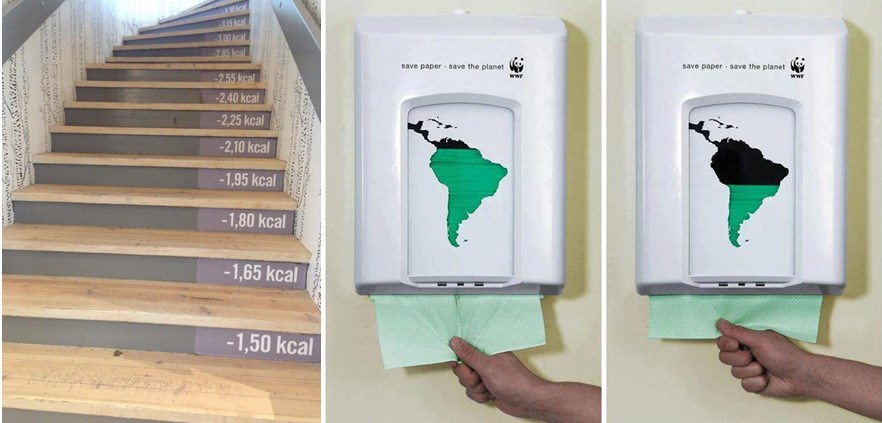The generation of any decision, from the purchase of a product to more complex choices, activates a complex neural network for processing information in parallel and in series, which can be influenced by many external and internal variables. Today we want to deepen the Nudge in the decision making process.
In previous articles we have seen how the decisions of human beings are strongly influenced by implicit thinking and the framing effect, how information is presented both at the macro level from the socio-cultural contexts of reference and from the presentation of the stimuli, and how the neurosciences they highlight the complexity of the substrate of cerebral, cognitive and emotional, implicit and rational pathways.
Scientific research allows us to evaluate how the human mind reacts to certain conditions and identify the decision-making processes that trigger the choices.
Knowing the principles of the functioning of the mind, it is possible to use strategies to create a context that favors the reaction of psychological engagement of “engagement” or it is possible to urge to perform certain behaviors with “kind suggestions”, both in the private context and in the public.
How do you identify the decision-making processes that trigger the choices? Find out what the # Nudge is
A gentle push to decisions: what is Nudging
Thanks to the studies of behavioral sciences, strategic elements can be used that favor certain cognitive and emotional paths, and that push to make certain choices and behaviors in a voluntary manner , conditioned by a “gentle push”: nudging , literally the act of gently pushing citizens towards more effective and efficient behavior for themselves and for the community, as demonstrated by Thaler and Sunstein , in the book “Nudge , the gentle push” (Feltrinelli, 2008).
Richard H. Thaler e Cass R. Sunstein present in practice the possibility of concocting the best choices of citizens, starting from the obvious assumption that human beings are precisely “Human”, endowed with heuristics and emotions, and not “ Econs “, beings endowed with the impeccable rational evaluation.
Knowing the automatic reasoning errors, heuristics and cognitive distortions that characterize Humans, it is possible to create the conditions to develop the “architecture of choices” of individuals with the aim of suggesting and promoting the best possible choices. These stimuli that act as “prods”, from pushes to certain actions, are simplifications of the decision-making process, such as for example varying the number and order of the alternatives of choice or selecting option of default .
Learning to identify and mediate the bio – psycho- automatic principles underlying Decision Making offers the opportunity to create the best context for favor certain choices at different levels.
A gentle push to make choices: that’s what # Nudge is for
The modification of the environmental context has always been adopted to improve the output of Marketing strategies and now the Nudging strategies are able to make the architecture of choices more efficient.
Advantages and effectiveness of Nudging
The English economist Baldwin points out:
“We are constantly subjected to ‘push by Marketing, there is always someone who wants to sell us something, and people are aware of it.”
As we know, many decisions are taken thanks to model 1, spontaneous thinking that requires little or no cognitive commitment, being guided by immediate emotions and instinctively triggered by the surrounding environment.
The advantage – which also determines the effectiveness – of Nudging is precisely being a gentle push, in keeping with one’s psychological functioning, and for this very reason, explains Prof. Baldwin:
“It is possible to address people, without forcing them, but simply by changing the way the choice is presented”.

Addressing people but not forcing them, simply by changing the way a choice is presented.
But be careful … if subjected to too many stresses, the danger is that people react automatically to the opposite of what is suggested to them.
For example, although we rationally want to eat healthy and lose weight, we continue to buy the chocolate bars available in vending machines. This type of “offer” fits perfectly with the immediate power of our automatic thought of pleasure that the finger gives us and people are instinctively induced to buy it.
How to promote specifics behavior
Can we promote target behavior by changing the offer of the environment?
Yes, we can.
Using the “pungoli”, simple stimuli that act as gentle pushes capable of condition the response of user behavior.
Being decision making based on the functioning of mental processes, mostly implicit, we can help certain decisions by using stimuli that create the conditions prone to certain choices, for example by varying the order of presentation of the alternatives of choice or by placing some options as default.
In TSW we work with the most innovative cognitive and behavioral strategies applied to Marketing and we apply nudging strategies also in promoting behavior by Health of our Human Resources. Let’s take the example of promoting Health, in line with the rational principle of “healthy life” and with the pragmatic goal: consumption of more fruit .
We kindly promoted the concrete behavior of eating more fruit during the day, offering in the recreation room inviting apples of the Pink Lady variety available to its collaborators, close but ahead of the vending machines full of bagged sweets.
We didn’t force anyone, but we kindly invited them to conduct, which was acted with awareness and pleasant surprise by the collaborators.
The presentation of the options and the temporality of these influence the behavior of the public.
As you wanted to prove.
Sounds Good!

Architecture of choices: Nudging is everywhere
Nudging strategies therefore work to promote subjects to make the best choice among different options, where presentation contexts are often structured to produce uncertain or poor results. Paolo Moderato, professor of General Psychology at the IULM, clarifies:
“It’s not about manipulation, but of an operation that, always respecting the freedom of the person, facilitates a behavior rather than another”.
The nudge it is everywhere, around us, in everyday life. From information on the media to the presentation of products at the supermarket: to make some information available or some products on display means providing one “Architecture of choices” that favors cognitive, emotional and behavioral responses, as well as exposing our Pink Lady in the recreation room they are a “push” towards a healthier concrete diet.
Every time we are faced with the creation of the presentation of stimuli that will be the starting point of a decision-making path for the user, the question arises as to how to organize its architecture. Thinking of these problems in terms of “architecture of choice”, we can leave it to chance or promote a path that respects ethics is appropriate to the achievement of target behaviors. We can “gently push” users to follow certain decision-making paths for better choices, simplifying the selection process, erasing unnecessary complexity.
At the Marketing level and in the specific digital environment, the study of the design of the presentation of the stimuli and the structure of the interfaces poses the problem of the best “architecture of choices”: it is possible to integrate the classic Marketing methods with the strategies of cognitive sciences and Neuromarketing, based both on observing the behavior of users in the face of certain stimuli, verifying their implicit psychological response, and on behavioral economics and Nudging strategies .
To confirm the validity and effectiveness of these new tools, know that internationally the diffusion of the theory and practice of Nudging is reported in the 2015 report “Mind, Society and Behavior” of the World Bank Group where it is highlighted how the psycho- social principles underlying the Decision Making can determine more functional behavioral choices: Thinking automatically , Thinking socially , and Thinking mental models .
The psycho- social principles underlying the # DecisionMaking: automatic thinking, social thinking and mental thought models
To confirm what the theory of nudging is spreading with evident success, we recall that even in September 2015 Barack Obama signed an executive order to promote the use and indications offered by behavioral sciences , after having appointed Sunstein as administrator of the Office of Information and Regulatory Affairs.
Yes, we can.
Other interesting information on Nudging find them here:
- Nudge your Customers Towards Better Choices from the Harvard Business Review
- Beyond nudges: Tools of a choice architecture from Springer Science and Business Media
